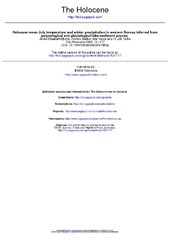Holocene mean July temperature and winter precipitation in western Norway inferred from palynological and glaciological lake-sediment proxies
Abstract
Reconstructions of mean July temperature (Tjul) and winter precipitation (Pw) for the last 11/500 years on the Folgefonna peninsula are presented. Tjul was reconstructed using pollen-climate transfer functions and Pw was reconstructed based on the exponential relationship between mean solid winter precipitation and ablation-season temperature at the equilibrium-line altitude (ELA) with a reconstructed former ELA, using Tjul as the proxy for ablation-season temperature. The reconstructions from the Folgefonna peninsula suggest that the early Holocene was relatively cool and dry until c. 8000 cal. yr BP, followed by a warm and humid mid-Holocene until c. 4000 cal. yr BP with inferred Tjul above 12°C and Pw reaching as high as 225% of the present day. Subsequent to c. 4000 cal. yr BP a reduction is seen in both inferred Tjul and Pw with large fluctuations during the last 500 years. In addition, new calculations of Pw from two glaciers (Hardangerjøkulen and Jostedalsbreen) in southern Norway are presented. The results show that Pw varied in phase at all glaciers, probably as a response to the same climate forcing factor. During the early Holocene a major shift is suggested between winds from the west and the east.
